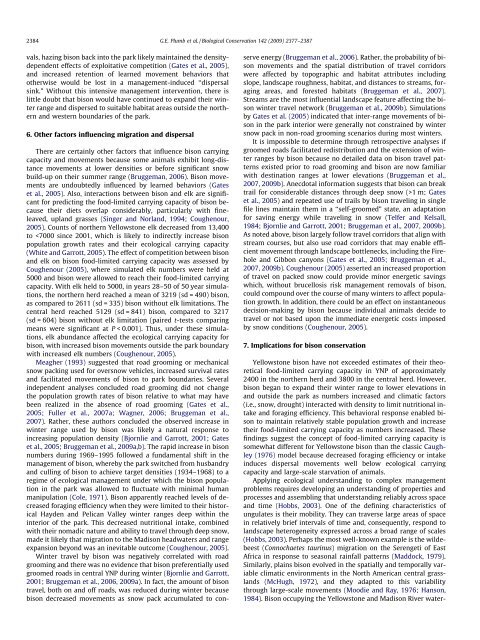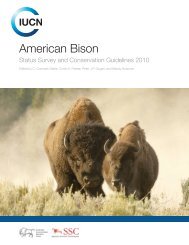Carrying capacity, migration, and dispersal in ... - ResearchGate
Carrying capacity, migration, and dispersal in ... - ResearchGate
Carrying capacity, migration, and dispersal in ... - ResearchGate
Create successful ePaper yourself
Turn your PDF publications into a flip-book with our unique Google optimized e-Paper software.
2384 G.E. Plumb et al. / Biological Conservation 142 (2009) 2377–2387<br />
vals, haz<strong>in</strong>g bison back <strong>in</strong>to the park likely ma<strong>in</strong>ta<strong>in</strong>ed the densitydependent<br />
effects of exploitative competition (Gates et al., 2005),<br />
<strong>and</strong> <strong>in</strong>creased retention of learned movement behaviors that<br />
otherwise would be lost <strong>in</strong> a management-<strong>in</strong>duced ‘‘<strong>dispersal</strong><br />
s<strong>in</strong>k.” Without this <strong>in</strong>tensive management <strong>in</strong>tervention, there is<br />
little doubt that bison would have cont<strong>in</strong>ued to exp<strong>and</strong> their w<strong>in</strong>ter<br />
range <strong>and</strong> dispersed to suitable habitat areas outside the northern<br />
<strong>and</strong> western boundaries of the park.<br />
6. Other factors <strong>in</strong>fluenc<strong>in</strong>g <strong>migration</strong> <strong>and</strong> <strong>dispersal</strong><br />
There are certa<strong>in</strong>ly other factors that <strong>in</strong>fluence bison carry<strong>in</strong>g<br />
<strong>capacity</strong> <strong>and</strong> movements because some animals exhibit long-distance<br />
movements at lower densities or before significant snow<br />
build-up on their summer range (Bruggeman, 2006). Bison movements<br />
are undoubtedly <strong>in</strong>fluenced by learned behaviors (Gates<br />
et al., 2005). Also, <strong>in</strong>teractions between bison <strong>and</strong> elk are significant<br />
for predict<strong>in</strong>g the food-limited carry<strong>in</strong>g <strong>capacity</strong> of bison because<br />
their diets overlap considerably, particularly with f<strong>in</strong>eleaved,<br />
upl<strong>and</strong> grasses (S<strong>in</strong>ger <strong>and</strong> Norl<strong>and</strong>, 1994; Coughenour,<br />
2005). Counts of northern Yellowstone elk decreased from 13,400<br />
to 1 m; Gates<br />
et al., 2005) <strong>and</strong> repeated use of trails by bison travel<strong>in</strong>g <strong>in</strong> s<strong>in</strong>gle<br />
file l<strong>in</strong>es ma<strong>in</strong>ta<strong>in</strong> them <strong>in</strong> a ‘‘self-groomed” state, an adaptation<br />
for sav<strong>in</strong>g energy while travel<strong>in</strong>g <strong>in</strong> snow (Telfer <strong>and</strong> Kelsall,<br />
1984; Bjornlie <strong>and</strong> Garrott, 2001; Bruggeman et al., 2007, 2009b).<br />
As noted above, bison largely follow travel corridors that align with<br />
stream courses, but also use road corridors that may enable efficient<br />
movement through l<strong>and</strong>scape bottlenecks, <strong>in</strong>clud<strong>in</strong>g the Firehole<br />
<strong>and</strong> Gibbon canyons (Gates et al., 2005; Bruggeman et al.,<br />
2007, 2009b). Coughenour (2005) asserted an <strong>in</strong>creased proportion<br />
of travel on packed snow could provide m<strong>in</strong>or energetic sav<strong>in</strong>gs<br />
which, without brucellosis risk management removals of bison,<br />
could compound over the course of many w<strong>in</strong>ters to affect population<br />
growth. In addition, there could be an effect on <strong>in</strong>stantaneous<br />
decision-mak<strong>in</strong>g by bison because <strong>in</strong>dividual animals decide to<br />
travel or not based upon the immediate energetic costs imposed<br />
by snow conditions (Coughenour, 2005).<br />
7. Implications for bison conservation<br />
Yellowstone bison have not exceeded estimates of their theoretical<br />
food-limited carry<strong>in</strong>g <strong>capacity</strong> <strong>in</strong> YNP of approximately<br />
2400 <strong>in</strong> the northern herd <strong>and</strong> 3800 <strong>in</strong> the central herd. However,<br />
bison began to exp<strong>and</strong> their w<strong>in</strong>ter range to lower elevations <strong>in</strong><br />
<strong>and</strong> outside the park as numbers <strong>in</strong>creased <strong>and</strong> climatic factors<br />
(i.e., snow, drought) <strong>in</strong>teracted with density to limit nutritional <strong>in</strong>take<br />
<strong>and</strong> forag<strong>in</strong>g efficiency. This behavioral response enabled bison<br />
to ma<strong>in</strong>ta<strong>in</strong> relatively stable population growth <strong>and</strong> <strong>in</strong>crease<br />
their food-limited carry<strong>in</strong>g <strong>capacity</strong> as numbers <strong>in</strong>creased. These<br />
f<strong>in</strong>d<strong>in</strong>gs suggest the concept of food-limited carry<strong>in</strong>g <strong>capacity</strong> is<br />
somewhat different for Yellowstone bison than the classic Caughley<br />
(1976) model because decreased forag<strong>in</strong>g efficiency or <strong>in</strong>take<br />
<strong>in</strong>duces <strong>dispersal</strong> movements well below ecological carry<strong>in</strong>g<br />
<strong>capacity</strong> <strong>and</strong> large-scale starvation of animals.<br />
Apply<strong>in</strong>g ecological underst<strong>and</strong><strong>in</strong>g to complex management<br />
problems requires develop<strong>in</strong>g an underst<strong>and</strong><strong>in</strong>g of properties <strong>and</strong><br />
processes <strong>and</strong> assembl<strong>in</strong>g that underst<strong>and</strong><strong>in</strong>g reliably across space<br />
<strong>and</strong> time (Hobbs, 2003). One of the def<strong>in</strong><strong>in</strong>g characteristics of<br />
ungulates is their mobility. They can traverse large areas of space<br />
<strong>in</strong> relatively brief <strong>in</strong>tervals of time <strong>and</strong>, consequently, respond to<br />
l<strong>and</strong>scape heterogeneity expressed across a broad range of scales<br />
(Hobbs, 2003). Perhaps the most well-known example is the wildebeest<br />
(Connochaetes taur<strong>in</strong>us) <strong>migration</strong> on the Serengeti of East<br />
Africa <strong>in</strong> response to seasonal ra<strong>in</strong>fall patterns (Maddock, 1979).<br />
Similarly, pla<strong>in</strong>s bison evolved <strong>in</strong> the spatially <strong>and</strong> temporally variable<br />
climatic environments <strong>in</strong> the North American central grassl<strong>and</strong>s<br />
(McHugh, 1972), <strong>and</strong> they adapted to this variability<br />
through large-scale movements (Moodie <strong>and</strong> Ray, 1976; Hanson,<br />
1984). Bison occupy<strong>in</strong>g the Yellowstone <strong>and</strong> Madison River water-










